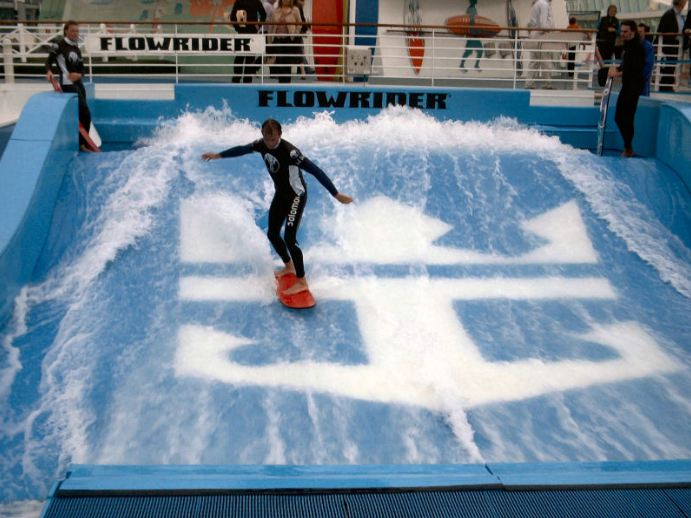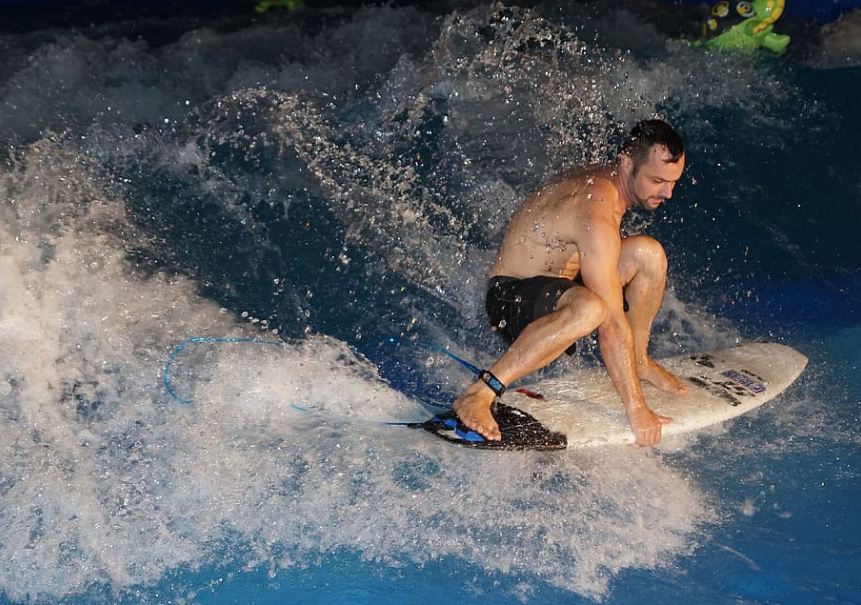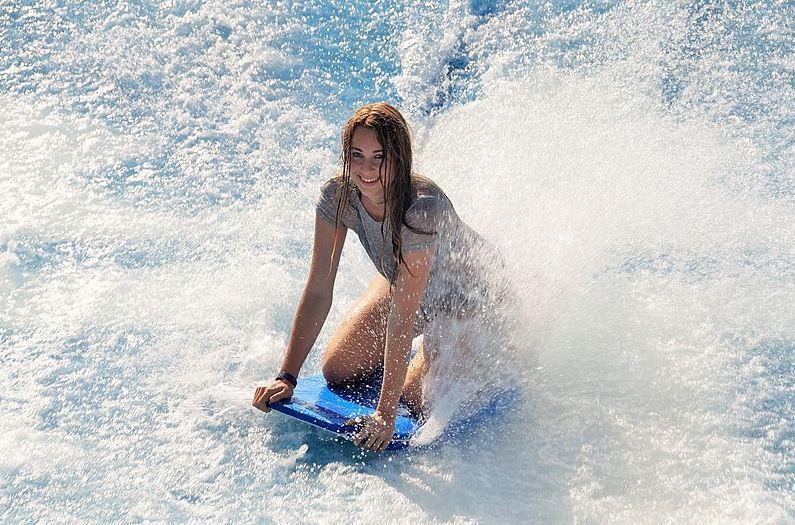Want to experience the thrill of riding a wave in a safe and controlled environment? Try flowriding – this could be the water sport for you if other adventurous water sports seem intimidating.
Flowriding, also known as flowboarding, is a thrilling water sport with non-stop appeal for people of all ages. This sport is a late 20th-century water board sport alternative that incorporates elements of surfing , skateboarding, bodyboarding , snowboarding, wakeboarding, and skimboarding. It takes place on an artificial wave called the FlowRider or FlowBarrel created by Wave Loch.
Beginners who might be apprehensive about surfing in the ocean will find that flowriding is the perfect alternative to experience the thrill of the waves indoors. But if you’re already familiar with surfing, you can perfect your skills, try to perform maneuvers, and learn tricks on a FlowRider without needing to take a trip to the beach.
How Does FlowRider Work?
FlowRider Inc. made technology that creates the ability to simulate ocean waves. FlowRider is the only company that produced such a device that is currently available in the market. At first, the devices can offer the simulation of breaking waves that attract surfers and bodyboarders.
FlowRider
The FlowRider operates by high-volume pumps that create a continuous sheet of flowing water over a specially-designed, soft riding surface. Flowriders can ride this “sheet wave” like the waves that move in the ocean. Gravity lets the rider drop in from the wave’s crest and slides down to the wave trough. The flowrider can ride up the wave surface by setting an edge and letting the water pressure push them back up the inclined wave surface.
Flowriders get their speed from the water’s energy flowing at them, and they can perform tricks and turns within a relatively small area. The curved surface of the machine matches the actual curve of the wave, and it changes throughout the surface to create a more realistic wave.
The machine pumps the water from the bottom up along the curved surface to make waves. The most significant difference between the machine’s and an actual ocean’s wave is that the flow rate of the water pushed along the surface of the FlowRider is larger than an actual wave. Then, a vacuum helps keep the riders from skipping dangerously along the water’s surface.
One needs some skill to control one’s position on the wave, and a movement too far in any direction will result in a wipe-out, out of the power flow and into the ride exit areas. But in just a few rides, anyone can get the hang of it and learn how to turn, drop, and climb on the wave face and perform some maneuvers.
FlowBarrel
The FlowRider company had another machine that allows riders to experience another form of a wave, and it’s called the FlowBarrel. It is designed to recreate tube riding, which is riding inside the curve of a breaking wave.
Equipment for Flowriding
Here are some of the stuff you need for flowriding:
Flowboard
The flowboard, also known as the stand-up board, is essential for flowriding. Boards differ in materials, shape, lengths, design, and the angle at which the board curves. Usually, they look the same as a wakeboard and can be further categorized into strapped and strapless boards. Strapless boards are used on both the FlowRider and FlowBarrel, while boards with foot straps are typically used only on the FlowBarrel.
Bodyboard
Bodyboarders ride standard bodyboards in the kneeling, drop-knee, or prone position. Any standard bodyboard can be used in the FlowRider.
Who can do Flowriding?
Flowriding is for almost everyone in good physical condition. Like other water sports, it’s a strenuous activity. Participants must be able to swim in turbulent waters to make sure they can be safe when they fall down the board. For people with a history of back, neck, shoulder, joint, or heart problems, or those who are pregnant, it’s best if they would not participate.
A minimum height of 42” is required to bodyboard and 52” to flowboard. This means children can participate, and they can actually pick up skills quite quickly. Children must be able to follow directions from an instructor and swim in turbulent moving waters.
Anyone who wants to do flowriding must be barefoot, and it’s best if they are wearing swimsuits or wet suits as the flow of the water can pull off bathing suit tops, bottoms, and other loose clothing.
Beginner Tips for Flowriding
When trying to ride the FlowRider, here are some tips to help and other expectations you must keep in mind:
1. Start by laying down on the board before starting to stand on a flowboard.
First-timers can expect to learn flowriding by laying down on the bodyboard, starting from the front of the wave, then learning how to turn side by side with their arms while leaving the legs dragging in the water to keep the board straight.
If you want to start flowriding, the first trick you’ll learn is pulling up unto your knees and leaving your toes in the water to act as a rudder. Then, put your hands in the water to keep the board straight. From there, a few other tricks can be learned on the board, even during the first session.
After trying the bodyboard, you can try out standing on the flow board. The instructor usually holds the board at the front of the wave while you hold onto a rope with your front hand. Then, you will step on the board with one foot at the front, and one at the back with knees bent and back leg leaned back. After that, slowly lower into the water, holding steady and not letting the water take the board away. Always keep the shoulders and hips straight while looking forward and keeping the board straight. Once you gain stability in the middle of the wave, you can try to carve side to side by pressing on your toes to go forward and heels to go back while keeping the board straight.
2. Expect to fall.
Falling is part of the sport, or of any board-based sports for that matter. It happens so suddenly that the best thing to do if you feel like a fall is going to happen is to sit down in the water and try to bring your arms close to your body. If you can’t anticipate it, try your best to bring your arms in and roll to your back. Don’t try to push against the water – it will only hurt your wrist. If possible, try to land on your behind to lessen the pain while falling, and always keep your limbs close to your body. The rushing water will push you up to the slope to a padded back wall whenever you fall. Let the flow take you to the top where you can get ahold of your boat and walk down the always on the side.
3. Look at the board.
If you have experience with surfing or snowboarding, you know that you don’t have to look on the board – you have to look up and far, into the direction you want to go. But this isn’t applicable for flowriding. You have to look at the board so you can gain control. Plus, you don’t need to look far and watch for something unexpected because the water flow is always constant.
4. Don’t move your upper body.
As soon as you’re able to balance on the board and maintain it, you can now learn to move along the wave. You can do this by simply shifting the weight from the back foot and going down by putting weight on the front foot. When making your turn, you can move the board horizontally by shifting your weight with your toes and heels. Unlike surfing, you don’t need to move your upper body so you can make a turn.



